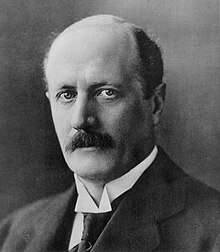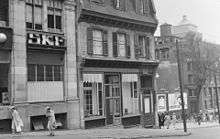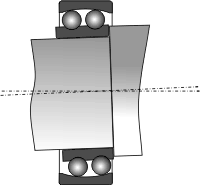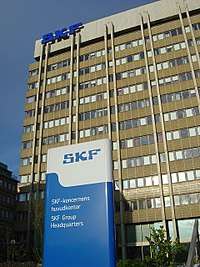SKF
AB SKF (Swedish: Svenska Kullagerfabriken; 'Swedish Ball Bearing Factory') is a Swedish bearing and seal manufacturing company founded in Gothenburg, Sweden, in 1907. The company manufactures and supplies bearings, seals, lubrication and lubrication systems, maintenance products, mechatronics products, power transmission products, condition monitoring systems and related services globally.[2]
 | |
 SKF building in Schweinfurt, Germany (2012) | |
| Publicly traded Aktiebolag | |
| Traded as | Nasdaq Stockholm: SKF B |
| ISIN | SE0000108201 |
| Industry | Manufacturing |
| Founded | 1907 |
| Founder | Sven Wingqvist |
| Headquarters | Gothenburg, Sweden |
Area served | Worldwide |
Key people | Hans Stråberg (Chairman) Alrik Danielson (President & CEO) |
| Products | |
| Revenue | |
| Total assets | |
| Total equity | |
| Owner | FAM AB (13.6%; 29.2% votes)[2] |
Number of employees | 43,360 (2019)[1] |
| Subsidiaries |
|
| Website | skf |
SKF is the world's largest bearing manufacturer,[3] and employs 44,000 people in 108 manufacturing units. It has the largest industrial distributor network in the industry, with 17,000 distributor locations encompassing 130 countries.[2] SKF is one of the largest companies in Sweden and among the largest public companies in the world.[4]
History



Sven Wingqvist, at the time a thirty-year-old plant engineer responsible for repairs and maintenance at Gamlestadens Fabriker, was dissatisfied with the performance of the ball bearings then in use. These were rigid ball bearings, imported from Germany, and if the long shafts on the machinery in a textile mill were the least bit misaligned, the ball bearings would become overheated and break down, bringing production to a costly halt. In spring 1907, Wingquist presented a breakthrough: a double row self-aligning ball bearing with a spherical raceway in the outer ring, shared by both rows of balls. This allowed the inner ring to align freely in relation to the outer ring, with no negative impact on the function of the bearing. The new bearing solved the problem associated with misalignment of the shafts and thus did away with the frequent production stops. Self-alignment was particularly useful in the less-than-perfect machinery of the times and in buildings with subsidence problems, which was the case at Gamlestadens Fabriker, since much of the land on which Gothenburg has been built is clay.
On 16 February 1907, Wingqvist applied for Swedish patent No. 25406, a multi-row self-aligning radial ball bearing. The Patent was granted on 6 June in Sweden coinciding with patents in 10 other countries. The new ball bearing was successful from the outset. Three years after SKF was founded, the company had 325 employees and a subsidiary in the United Kingdom. Manufacturing operations were later established in multiple countries.
By 1912, SKF was represented in 32 countries and by 1930, a staff of over 21,000 were employed in 12 manufacturing facilities worldwide with the largest in Philadelphia, United States.
SKF began its operations in India in 1923 by establishing a trading outpost in Calcutta. The early operations involved the importing of automotive bearings. SKF India Ltd was incorporated in 1961 following a collaboration between AB SKF, Associated Bearing Co. Ltd and Investment Corp. of India Ltd. In 1963, SKF set up its first bearing factory in Pune, Maharashtra.[5]
Assar Gabrielsson, SKF sales manager, and Björn Prytz, Managing Director of SKF were the founders of Volvo AB in 1926. In the beginning, the company functioned as a subsidiary automobile company within the SKF group. SKF funded the production run of the first thousand cars, built at Hisingen in Gothenburg, beginning in 1927. SKF used one of the company's trademarked names: AB Volvo, which derives from the Latin "I roll", with its obvious connotations of bearings in motion. The ownership of Volvo lasted until 1935 when the last shares were divested.
In the 1970s SKF embarked on a massive production rationalisation program in Europe. A visionary project, "Production Concept for the 80s" was launched with the aim to run the night shifts practically unmanned. To increase productivity and safeguard the product quality, a continuous, automatic flow of bearing rings was needed, so SKF developed the Flexlink brand. FlexLink created the multiflex plastic chain conveyor system to solve the business requirements. SKF divested FlexLink as a separate company in 1997.
Present day business

The SKF Group currently consists of approximately 150 companies including the seal manufacturer Chicago Rawhide. Since its founding, SKF's company headquarters have been located in Gothenburg. One recent acquisition was that of Economos, part of Salzer Holding, an Austria-based seal company, Jaeger Industrial and ABBA, Taiwanese manufacturers of linear actuators. The company's clients include General Electric, Rolls-Royce plc and Pratt & Whitney. It also supplies bearings for Ferrari racing vehicles, used in Formula One races,[6] and is a sponsor of F1.Then SKF became sponsor of Team Penske in Monster Energy NASCAR Cup Series since 2012, Then in 2017 SKF became as Brad Keselowski sponsor in #2 Ford Fusion and #22 Ford Mustang in Xfinity Series, Previously, it is Sponsor of Richard Childress Racing, and Roush Fenway Racing, SKF is Sponsor of Ducati in MotoGP since 2015.Another focus area is the energy sector, including wind turbines which generate electricity.
By 2011, SKF Industrial Market, Regional Sales and Services, made up about 40% of SKF's total sales.[7]
SKF employs 3,000 people across six factories in India and has 27% market share of the industrial and automotive bearings market.[5]
2016 SKF had a total net sales of 72,787 SEKm.[2]
Products
SKF sells products within five technology platforms:
- Bearings and Units
- Mechatronics
- Lubrication Systems
- Services
- Seals
Business excellence
SKF runs its own business excellence program for continuous improvement (Kaizen) of its business processes in all parts of the company. The program is based on previous initiatives like TQM and integrates with lean management also statistical methods of Six Sigma along with related project management.[8] Many elements of this SKF program remind of the integrated approach of the actual EFQM model for Business Excellence.
The Group has a global certification to IS0 14001 (environmental management system), ISO 50001 (energy management) and OHSAS 18001 (health and safety) standards. Its operations are also certified to either ISO 9001 or applicable customer industry standards, e.g. ISO/TS 16949 (automotive), AS9100 (aviation), or IRIS (railway) for quality management systems.
See also
- List of Swedish companies
Company history references
- Fritz, Martin and Karlsson, Birgit (2006). SKF: A Global Story, 1907-2007. ISBN 978-91-7736-576-1
- Steckzén, Birger (1957). SKF: The History of a Swedish Export Industry, 1907-1957. (in Swedish)
References
- "Annual Report 2019" (PDF). SKF.
- "Annual Report 2016" (PDF). SKF. pp. 9, 16, 55, 66, 68, 102.
- "Bearings". SKF. Retrieved 2 October 2017.
- "SKF Group on the Forbes Global 2000 List". Forbes.com. Retrieved 2 October 2017.
- Mishra, Ashish K. (11 November 2014). "SKF and the business of movement". Livemint.com. Retrieved 2 October 2017.
- "Demand Forecasting - Forecasting, Demand Forecasting & Planning, S&OP, CPFR - Manufacturing & Logistics IT Magazine". Logisticsit.com. Retrieved 2 October 2017.
- "SAMA Adds New Board Member". PR Newswire (via Yahoo News). 3 October 2013. Archived from the original on 3 October 2013.
- "Business Excellence in SKF" (PDF). sandholm.se. Archived from the original (PDF) on 2011-08-26. Retrieved 2011-06-18.
(Presented by Tom Johnstone during the Lean & Six Sigma 2011 conference in Stockholm)
External links
| Wikimedia Commons has media related to SKF. |
- official website SKF Group
- official website SKF Vehicle aftermarket
- SKF Bearings
- Documents and clippings about SKF in the 20th Century Press Archives of the ZBW